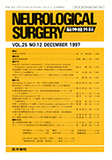Japanese
English
- 有料閲覧
- Abstract 文献概要
- 1ページ目 Look Inside
I.はじめに
高血圧性脳内出血の中で視床出血は,その局在と進展方向および血腫量によって神経症状が大きく異なり,神経解剖学的にも非常に興味深い疾患である.内包後脚を走行する錐体路の局在については,Foersterの図示以来,内包後脚の大部分を占める説明図が用いられてきたが,近年その局在は内包後脚の後半部に限局しており,更に吻側から尾側にかけて前方から後方に偏位するとの見方が強まってきた6).その一方で,視床出血の進展形式と神経症状の解析から,数多くの臨床分類が報告されてきた.
今回,視床出血の局在と運動麻痺を対比させることで,錐体路の解剖学的局在について症候学的に検討を加えたので報告する.
To better understand the pyramidal tract of the inter-nal capsule, we evaluated the relationship between the localization of thalamic hemorrhage and motor weak-ness. On an axial CT scan at the level of the pineal body, two lines were drawn as follows: line-a between the lateral edge of the anterior horn and the lateral edge of the trigone; line-b vertical to the sagittal line and passing the midpoint of the third ventricle. The location of the hematoma was classified into three types according to localization of the center of the hematoma and lateral extension beyond line-a as follows: type A (anterior), type P (posterior) and type PL (postero-lateral).
Discrepancy of motor weakness between upper extre-mities and lower extremities was higher in patients with hematoma of type P and type PL (p<0.05) than in those with hematoma of type A. Improvement of motor weakness on discharge was higher in patients with type P (p<0.01) than in those with type A.
We concluded that most of the pyramidal tract fibers were located in the third quarter of the posterior limb of the internal capsule but a small number of pyramidal tract fibers were located in the anterior two-thirds of it. A greater number of cortico-spinal fibers to the upper extremities than to the lower extremities occupy the third quarter of the posterior limb of the internal cap-sule.

Copyright © 1997, Igaku-Shoin Ltd. All rights reserved.


